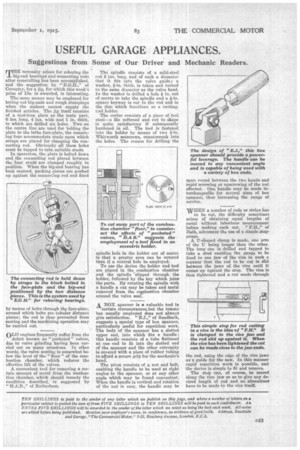USEFUL GARAGE APPLIANCES.
Page 27

If you've noticed an error in this article please click here to report it so we can fix it.
Suggestions from Some of Our Driver and Mechanic Readers.
THE necessity arises for reboring the big-end bearings and connecting rods after remetalling has been accomplished, and the suggestion by "E.G.H.," of Coventry, for a jig, for which this week's prize of 15s. is awarded, is interesting.
The same means may be employed for boring out big-ends and rough stampings when the makers cannot supply the finished articles. The jig itself consists of a cast-iron plate as the main part, {I ins. long, 4 ins, wide and 1 in. thick, in which are drilled six holes. Two on the centre line are used for bolting the plate to the lathe face-plate, the remaining four accommodate studs upon which straps are placed for clamping the connecting rod. Obviously all these holes must be tapped to take suitable studs.
In operation, the plate is bolted down and the connecting rod placed between the four studs are clamped roughly in position. When the big-end bearing has been centred, packing pieces are pushed up against the connecting rod and fixed by means of bolts through the face-plate, around which bolts are tubular distance pieces ; the rod is thus prevented from moving and the machining operation may be carried out.
OLD engines frequently suffer from the defect known as " pocketed " valves, due to valve grinding having been carried out on many occasions. In other words, the valve seating is somewhat below the level of the " floor " of the combustion chamber, which reduces the effeetive lift of the valves.
A convenient tool for removing a certain amount of metal from the combustion chamber, which should remedy the condition described, is suggested by " }LA.B.," of Rotherham.
The spindle consists of a mild-steel rod 8 ins, long, and of such a diameter that it fits into the valve guide ;• a washer, *-in. thick, is taken and turned to the same diameter as the valve head, In the washer is drilled a hole *in. out of centre to take the spindle and a square keyway is cut in the rod and in the disc which functions as a cuttingtool holder.
The cutter consists of a piece of tool steel—a file softened and cut to shape is quite satisfactory if subsequently hardened in oil. The tool is fastened into the holder by means of two I-in. Whitworth setscrews, countersunk into the holes. The reason for drilling the spindle hole in the holder out of centre is that a greater area can be covered than if a central hole be employed.
To use the device the holder and tool are placed in the combustion chamber and the spindle slipped through the holder, followed by the key which joins the parts. By rotating the spindle with a handle a cut may be taken and metal removed from the combustion chamber around the valve seat.
A BOX spanner is a valuable tool in
certain circumstances, but the tommv has usually employed does not always give satisfaction. "B.I.," of Sandbach, suggests a special type of box spanner, particularly useful for repetition work. The body of the spanner has a slotted upper end, into which fits a handle ; this handle• consists of a tube flattened at one end to fit into the slotted end of the spanner and the other extremity is covered with a piece of rubber tubing to afford a secure grip for the mechanic's hand.
The pivot consists of a nut and bolt, enabling the handle to be mied at right angles to the spanner, or at any other angle which may be found convenient. When the handle is vertical and rotation of the nut is easy, the handle may be spun round between the two hands and rapid screwing or unscrewing of the nut effected. One handle may be made interchangeable for several sizes of box spanner, thus increasing the range of service.
WHEN a number of rods or strips has to be cut, the difficulty sometimes arises of obtaining equal lengths of metal without laborious measurement before making each cut. "PH.," of Bath, advocates the use of a simple stopgauge.
A U-shaped clamp is made, one arm of the U being longer than the other. The long one is drilled and tapped to take a stud enablin., the gauge to be fixed to one jaw of the vice in such a manner that the rod to be cut is slid between the jaws of the vice until it comes up against the stop. The vice is then tightened and a cut made through
the rod, using the edge of the vice jaws as a guide for the saw. In this manner rapid repetition work is possible, and the device is simple to fit and remove.
The stop can, of course, be moved along the vice jaw so as to give any desired length of rod and no alterations have to be made to the vice itself.




























